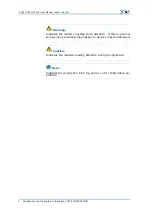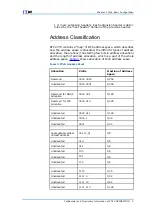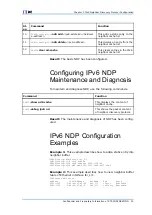
ZXR10 T600/T1200 User Manual (IPv6 Volume)
Hex
Decimal
Value
4
4
Unallocated
5
5
Site-local range
6
6
Unallocated
7
7
Unallocated
8
8
Institution-local
range
9
9
Unallocated
10
A
Unallocated
11
B
Unallocated
12
C
Unallocated
13
D
Unallocated
14
E
Global range
15
F
Reserved
�
Group ID field
The 112-bit multicast ID field identifies a multicast group
within a specified range permanently or temporarily.
�
Anycast Address
A multicast address can be shared by many nodes in a sense.
All the nodes of the members of a multicast address expect
to receive all the packets sent to this address. A router con-
necting to five different local Ethernet networks shall forward
a copy of these multicast packets to each network respectively
(supposing at least one node of each network subscribs to this
multicast address).
Anycast addresses are similar to multicast addresses.
Al-
though the two are in the same case that an anycast address
can be shared by multiple nodes, only one node of an anycast
address expects to receive the packet sent to the anycast
address.
Anycast is helpful in providing services, especially those re-
quiring no relationship between client and server, such as, a
domain name server and a time server. A domain name server
is nothing but a name server, which provides the same perfor-
mance whether it is located closely or remotely.
Similarly, a closely located time server is preferable in terms
of accuracy. Therefore, when a host sends a request to an
anycast address to obtain information, it is the nearest server
associated to this anycast address that shall respond.
Anycast addresses are allocated outside of the normal IPv6 uni-
cast address space. Anycast addresses cannot be distinguished
from unicast addresses in their forms, and each member of
12
Confidential and Proprietary Information of ZTE CORPORATION
Summary of Contents for ZXR10 T1200
Page 5: ...Figures 71 Tables 73 List of Glossary 75 ...
Page 6: ......
















































